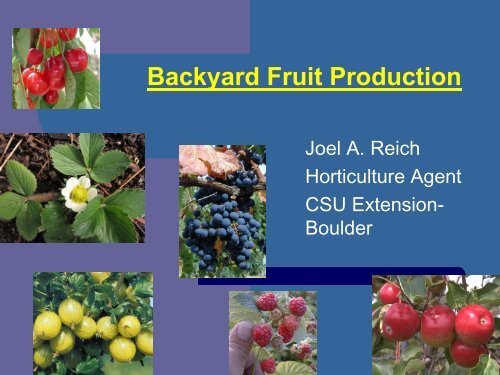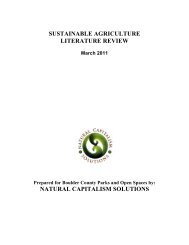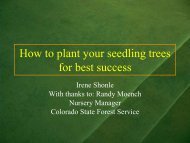Backyard Fruit Production
Backyard Fruit Production
Backyard Fruit Production
Create successful ePaper yourself
Turn your PDF publications into a flip-book with our unique Google optimized e-Paper software.
<strong>Backyard</strong> <strong>Fruit</strong> <strong>Production</strong><br />
Joel A. Reich<br />
Horticulture Agent<br />
CSU Extension-<br />
Boulder
<strong>Fruit</strong> Groups<br />
Pome fruits- Apple, pear, quince<br />
Stone fruits (Drupes)- Peach, plum, apricot, cherry<br />
Cane berries- raspberries, blackberries, hybrids<br />
Vine fruits- Grapes, kiwis<br />
Shrub/bush fruits- Blueberries, currants,<br />
gooseberries
Tree <strong>Fruit</strong>s
Planning an orchard<br />
Do a soil test at least one year prior and<br />
correct problems prior to plant<br />
Select certified (true to name, virus-free, and<br />
pathogen-free stock)<br />
Ideally, use one-year<br />
old stock<br />
Use dwarfing or semi-dwarfing<br />
rootstock
Cultural practices<br />
Site location:<br />
Full Sun<br />
On a slope<br />
Late spring frosts are biggest problem with<br />
backyard tree fruit production on the Front<br />
Range<br />
– Rigid frame?
Cultural practices continued<br />
Soils – well drained, loam is best<br />
Light – Full sun for at least 8 hours per day<br />
Terrain – gently rolling to allow air moderation<br />
and circulation<br />
Fact Sheet # 7.003, 2.926 & 2.932
Wildlife considerations<br />
Rabbits<br />
Birds<br />
Deer<br />
Bears<br />
Trunk protection<br />
Fencing<br />
Netting
Pruning Objectives<br />
Develop desired tree shape<br />
Maintenance<br />
Ease of spraying<br />
Improved fruit quality<br />
Improved strength and induce branching<br />
Improved air circulation
Training and pruning systems<br />
Open Vase System<br />
Modified Central Leader<br />
Espalier<br />
Trellis<br />
Remember to remove weak and crossing wood.<br />
Shown is Modified Central Leader
20 Year old Standard Apple<br />
Open Vase System
Whip – on arrival<br />
Yr. 1 & Yr. 2<br />
Modified Central<br />
Leader
Watch branch collar – Fact Sheet 7.003
Flowering and thinning (7.002)<br />
Only need 7% of the available flowers to<br />
produce fruit<br />
Natural fruit drop – first drop occurs 2 to 3<br />
weeks after pollination; June drop<br />
Thinning agents – cultivar specific; follow label<br />
instructions (bees & Sevin)
Propagation Terminology<br />
Cloning<br />
Mound layering<br />
Trench layering<br />
Grafting (Whip or T-bud)<br />
“Basket of<br />
<strong>Fruit</strong>”
<strong>Fruit</strong> Tree Nutrition<br />
P, K important in Fall (1:5:4)<br />
N important in Spring (5:1:1)
Tree <strong>Fruit</strong> Spurs
Apples<br />
Malus pumila or M. domestica<br />
Many uses including dessert,<br />
fresh and cooking<br />
Standard trees vs dwarf cultivars<br />
Usually a need for second cultivar
Apple cultivars (all are cloned)<br />
Acceptable:<br />
Gala<br />
Johnagold<br />
McIntosh<br />
Johnathan<br />
Winesap<br />
Rome Beauty<br />
Johnny Crisp<br />
Avoid:<br />
Yellow Delicious<br />
Delicious<br />
Granny Smith<br />
Mutsu<br />
Fuji<br />
And other cultivars with<br />
longer DTH
Apple pollination<br />
Fact<br />
sheet #<br />
7.002
Coddling Moth<br />
Number 1 pest for backyard growers<br />
Proper thinning and pruning<br />
Pheromone trapping - 2 to 3 generations per<br />
year<br />
Utilize control measures<br />
as necessary – never<br />
apply pesticides<br />
during bloom
Aphids<br />
Use dormant oils before leaf out, why?<br />
Utilized water spray to dislodge insects<br />
Utilize soap when appropriate<br />
Wooly apple aphid more difficult to control due<br />
to waxy honeydew<br />
Review Fact Sheets 5.547 & 5.569 – do not<br />
use any systemic on edible products
Aphids<br />
Winged or wingless<br />
See Fact Sheet 5.511
Pears<br />
Pyrus communis – European Pear<br />
P. serotina or P. pyrifolia – Asian Pear<br />
Often bloom prior to apples<br />
23 species of pears –<br />
many long-lived in the<br />
environment
Pear cultivars<br />
Acceptable European:<br />
Bartlett<br />
Bosc<br />
d’Anjou<br />
Acceptable Asian:<br />
Kieffer<br />
LeConte<br />
Garber<br />
Avoid:<br />
Hardy<br />
Comice<br />
Magness*<br />
Seckel*<br />
*Sterile needs pollinizer
Pear pollinators
Special needs for pears<br />
Use open vase, modified central leader or<br />
espalier<br />
<strong>Fruit</strong> is borne on previous years growth and<br />
spurs that are 2+ years old
Quince<br />
Cydonia oblonigata (Chinese quince) or Chaenomeles<br />
speciosa (Common Quince)<br />
Used as dwarfing rootstock for pears<br />
Maybe used in backyard production
Quince continued<br />
Common in Europe<br />
Graft incompatibility problems and other<br />
problems like apple and pear<br />
Use cutivars that are fireblight resistant<br />
Use as a landscape ornamental
Peaches and Apricots<br />
Relative hardiness<br />
Chilling requirement<br />
Intolerant of heavy soils and high pH<br />
Chlorosis<br />
Gumosis and Cystospora canker
Cherries<br />
Prunus cerasus –<br />
Tart cherry<br />
Self-fruitful<br />
Use healthy one-year old whip, approx. 4 to 6<br />
ft. tall, ½” caliper with good root system
Cherries continued<br />
Sweet cherries have similar hardiness<br />
problems as peaches<br />
Larimer County was #2 in USA in tart cherry<br />
production prior to 1951<br />
Use open vase, modified central leader or<br />
central leader
Cherry cultivars (tart)<br />
Northstar<br />
Montmorency<br />
Meteor<br />
See Fact Sheet 7.002
Cultural care of cherries<br />
Self-fruitful<br />
Frost damage (may need protection)<br />
Avoid compaction and use mulch around<br />
cherries<br />
Watch for nitrogen deficiency
Biotic disorders of Cherries<br />
Powdery Mildew<br />
Cytospora / Gumosis – often accompanies<br />
crown borer
Other diseases of Cherries<br />
Phytopthera<br />
Verticillium Wilt<br />
All usually accompany wounding and/or<br />
associated with wet soils.
Insects<br />
Peach crown borer<br />
Peach twig borer<br />
Aphid – see previous notes<br />
Scales<br />
– Dormant Oils prior to leaf-out<br />
Pear slug<br />
– Use charcoal ash to dust the foliage<br />
Peach Twig Borer
Plums<br />
Prunus domestica –<br />
European Plum<br />
P. salincina – Oriental or Japanese Plum<br />
P. americana –<br />
American or native plum
European / Oriental Cultivars<br />
Acceptable:<br />
Imperatrice (E)<br />
Green Gage (O)<br />
Yellow Egg (E)<br />
Lombard (E)<br />
Stanley (E)<br />
Avoid:<br />
Burbank<br />
Ozark<br />
Premier<br />
Explorer
Plums
Cultural care of plums<br />
Flowering characteristics – thinning<br />
Prune in open vase (Oriental) or modified<br />
central leader (European)<br />
<strong>Fruit</strong>s on spurs and previous years’ growth
Cultural care of plums<br />
Place in sheltered area within the landscape<br />
May require additional Nitrogen<br />
Clean and remove plant material, inc. fruit
Plum pollinators
Small <strong>Fruit</strong>s
Strawberry Culture<br />
Fragaria x ananassa<br />
Cultivars are classed as<br />
June-bearing,<br />
everbearing, day neutral<br />
Have photoperiod<br />
response
Cultural Requirements<br />
Site selection: require at least 8 hours of<br />
sunlight and protection from wind<br />
Do not plant after solanaceous crops or<br />
raspberries<br />
Proper planting depth, mulch and rotation
Cultural Requirement:<br />
Irrigation: trickle or overhead<br />
Frost protection<br />
Row covers; weeds<br />
Harvest and post-harvest considerations
Junebearing cultivars<br />
Acceptable<br />
– Honeoye<br />
– Guardian<br />
– Kent<br />
– Gem<br />
– Carskill<br />
– Geneva<br />
Avoid<br />
– Dunlap<br />
– Fairfax<br />
– Robinson<br />
– Red Star
Everbearing Cultivars<br />
Acceptable<br />
– Quinalt<br />
– Ogallala*<br />
– Ft. Laramie<br />
Avoid<br />
– Ozark Beauty<br />
– Rockhill
Day Neutrals<br />
Tribute<br />
Tristar<br />
Fern
Biotic Disorders<br />
Numerous – Lygus (plant) bug is # 1<br />
Aphids<br />
Slugs & Millipedes<br />
Diseases<br />
Follow good cultural control: remove debris,<br />
use certified pathogen-free stock & scout
Lygus bug<br />
Control weeds, alfalfa and<br />
legumes<br />
Utilize insecticidal soap –<br />
avoid treating during bloom<br />
Use sweep nets<br />
Vacuum
Strawberry Nutrition<br />
N promotes excess growth and runners<br />
P and K are critical for good fruit set<br />
Fall fert. Is key to bud devel.
Planting Systems<br />
Matted row<br />
Hill system
Raspberry Culture<br />
Rubus odoratus<br />
Rubus ideaus or Red<br />
Raspberry<br />
R. occidentalis (Black<br />
Raspberry)<br />
R. neglectus (Purple<br />
Raspberry)<br />
Many other subspecies
Cultural Requirements<br />
Full sun<br />
Well-drained soil<br />
Support<br />
Proper pruning
Pruning and Training systems<br />
Floricane fruiting vs. Primocane fruiting<br />
– Think of each cane as a biennial plant<br />
Any kind of trellis is better than laissez-faire heap
Red raspberry cultivars<br />
Acceptable<br />
– Heritage<br />
– Honey Queen<br />
– September Red<br />
– Fall Red<br />
– Red Wing<br />
– Fall Gold<br />
– Pathfinder<br />
– Trailblazer<br />
Avoid<br />
– Latham<br />
– Boyne
Ribes spp.<br />
Currants<br />
Gooseberries<br />
Jostaberries<br />
Woody perennial shrubs –<br />
3 to 6’<br />
Most are self-fruitful
Gooseberrries<br />
Thorny!<br />
Delicious!<br />
Self-fruitful<br />
Avoid growing white pine<br />
nearby
Gooseberry cultivars<br />
Acceptable<br />
– Poorman<br />
– Hinnomaki Yellow<br />
– Welcome<br />
– Hinnomaki Red<br />
– Invicta<br />
– Early Sulfur<br />
– Red Jacket*<br />
Avoid<br />
– Pixwell<br />
– Downing<br />
– Colossal<br />
Jostaberries<br />
– Josta
Currants<br />
Red currants<br />
– Red Lake<br />
– Wilder<br />
– Cherry<br />
– Perfection<br />
– Jhankeer Van Tets<br />
– White Grape<br />
– White Imperial<br />
Black currants<br />
– Boskoop Giant<br />
– Ben Nevis<br />
– Brodtrop<br />
– Consort<br />
– Crusader<br />
– Crandall*
Black Currant<br />
All Ribes do best in<br />
fertile, loamy soil with<br />
good drainage. Optimal<br />
pH of 6.2 to 6.5 is<br />
desired<br />
Plant on northern facing<br />
slopes & plant 1 to 2”<br />
LOWER than previously<br />
grown.
Red Currant
Sambucus canadensis Elderberry<br />
High in Vit.C; used in<br />
jellies & pies<br />
Plant 5 to 7 ft. on center<br />
– pruning out wood after<br />
third year<br />
Landscape value for<br />
wildlife
Elderberry<br />
Tolerate most soil types<br />
and most drainage<br />
conditions<br />
Be careful tilling near<br />
roots!!!<br />
Partially self-fruitful
Elderberry<br />
Cultivars:<br />
– Adams #1<br />
– Adams #2<br />
– Johns<br />
– New York 21<br />
– Nova<br />
– Scotia<br />
– York
Grapes – Vitis spp.<br />
Common problems<br />
include:<br />
– Poor drainage<br />
– Poor quality vine purchase<br />
– Planting too late in the<br />
season<br />
– Poor use of irrigation<br />
– Inadequate control of<br />
weeds and diseases
Site preparation<br />
Remove all trees,<br />
stumps, rocks, wire, etc.<br />
Deep tillage maybe<br />
needed<br />
Soil test & space<br />
appropriately
Cultivars to consider<br />
Himrod<br />
Interlaken<br />
Lakemont<br />
Concord<br />
Niagara<br />
Stueben<br />
Golden Muscat<br />
Vanessa<br />
Reliance<br />
Canadice
Pruning<br />
Grapes
Pruning<br />
established<br />
grape vines
Grapes after pruning
Discuss Blackberries and<br />
Blueberries…
Make Sure to have FUN!

















